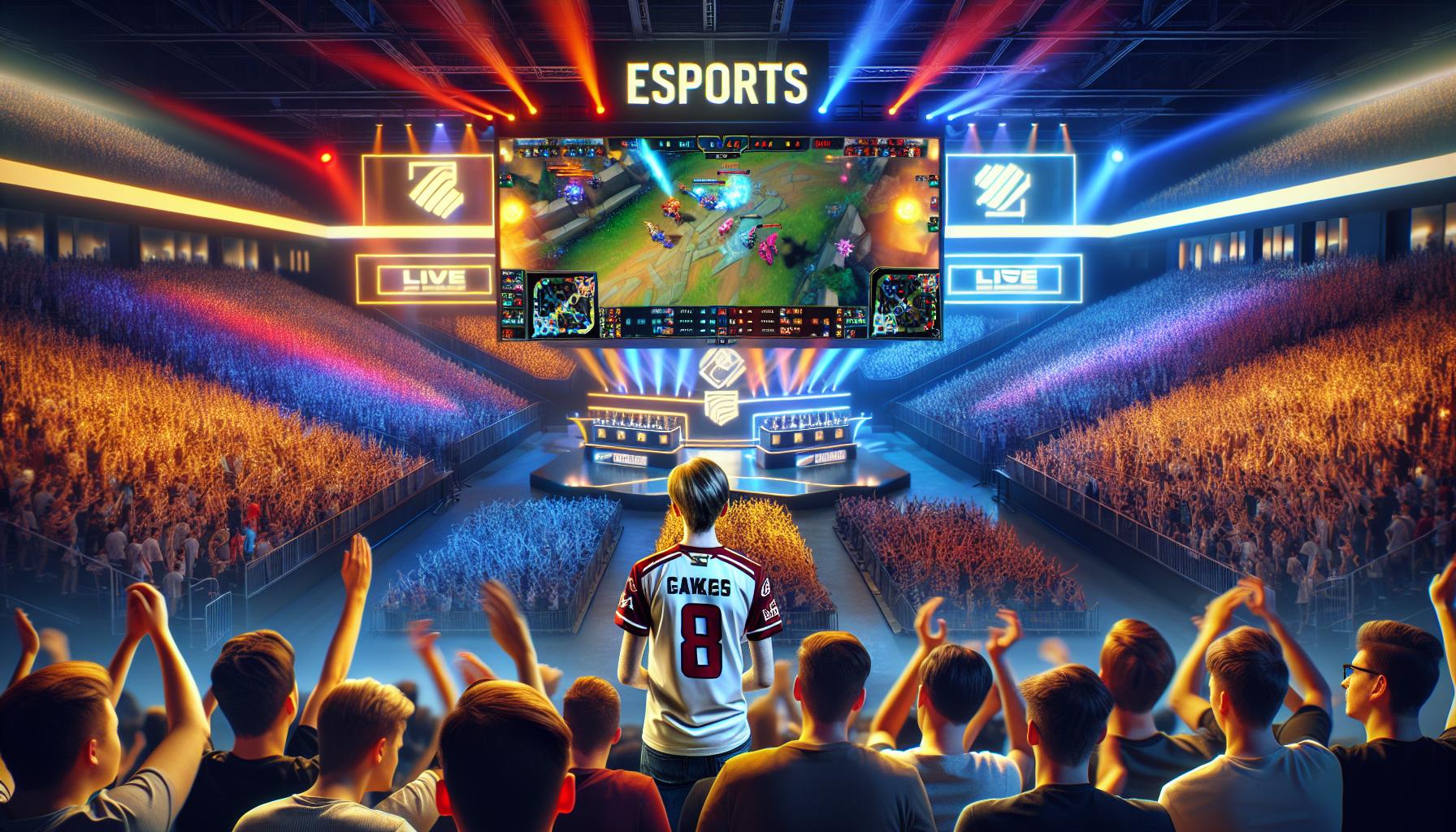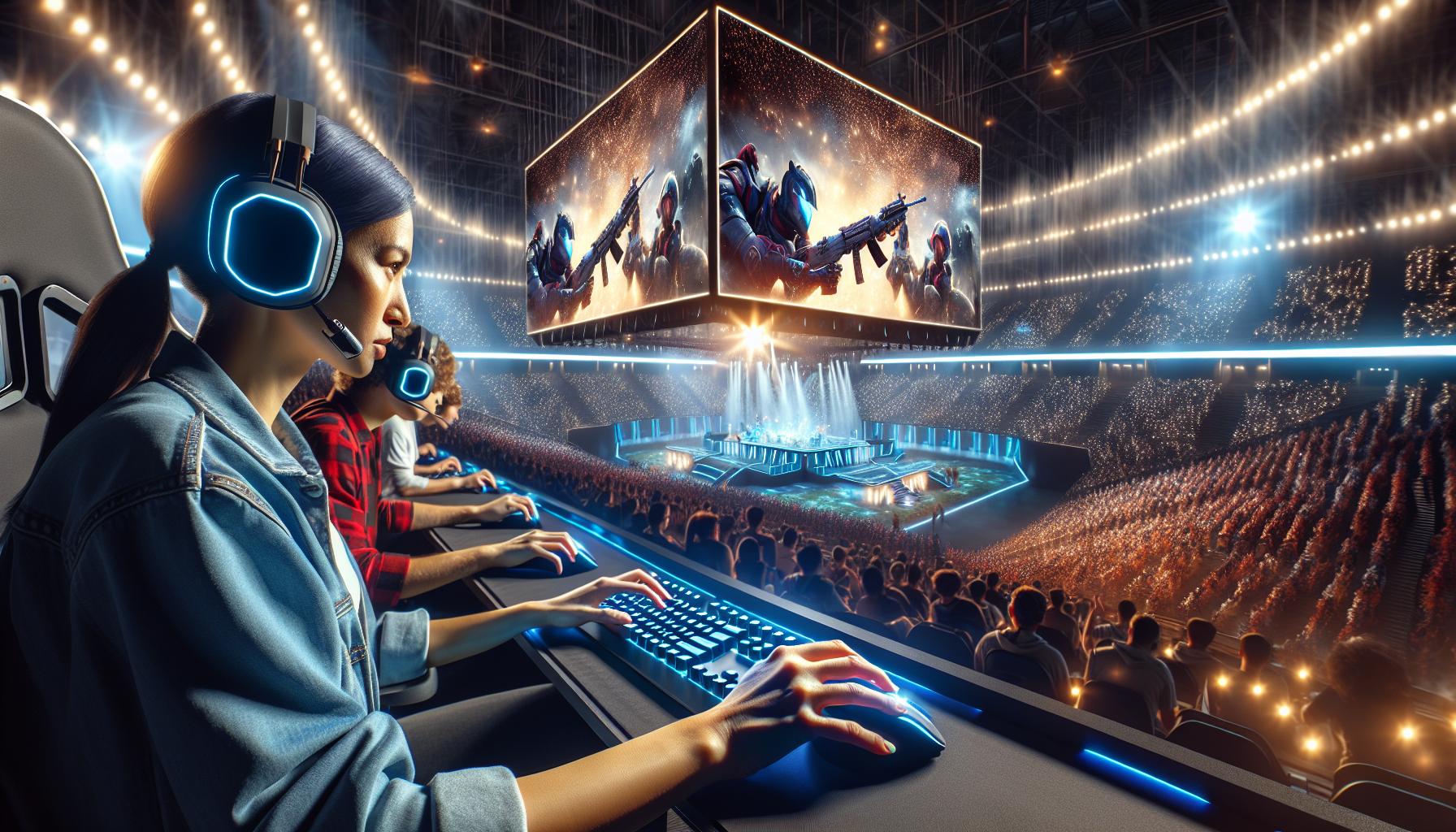Key Takeaways
- Esports as a Global Phenomenon: Esports has evolved into a mainstream entertainment industry with a global audience of over 532 million and high-stakes tournaments attracting millions of viewers.
- Multi-Billion Dollar Industry: Valued at approximately $1.5 billion in 2023, esports generates revenue through sponsorships, advertising, ticket sales, and merchandise, making it a lucrative business sector.
- Diverse Game Genres: Esports encompasses various genres, including FPS, MOBA, and battle royale games, each offering unique competitive experiences and attracting distinct fan communities.
- Influence of Streaming: Platforms like Twitch and YouTube play a pivotal role in the esports ecosystem, significantly boosting viewership and allowing for real-time interactions between fans and players.
- Emerging Career Opportunities: Academic institutions are increasingly offering specialized programs in esports management, coaching, and marketing, paving the way for numerous career paths in the burgeoning industry.
- Integration with Traditional Sports: Esports is increasingly collaborating with traditional sports organizations, fostering a crossover that enhances engagement and expands the reach of both sectors.
Esports has rapidly transformed from a niche hobby into a global phenomenon, captivating millions of fans and players alike. As competitive gaming gains mainstream recognition, its impact on culture, entertainment, and even education grows stronger. With massive tournaments and professional leagues attracting top talent, it’s clear that esports is here to stay.
Understanding the dynamics of this exciting world is essential for both enthusiasts and newcomers. From staggering prize pools to dedicated fanbases, the landscape of esports is filled with fascinating facts that reveal its true potential. Dive into these ten intriguing insights that showcase the evolution and significance of esports in today’s society.
10 Facts About Esports
Esports encompasses organized competitive gaming, where individuals or teams compete in popular video games. Titles such as “League of Legends,” “Dota 2,” and “Counter-Strike: Global Offensive” dominate the landscape, attracting millions of players and fans worldwide. Tournaments and leagues showcase top talent, featuring substantial prize pools often exceeding millions of dollars.
Esports events attract large audiences, both in-person and online. Major tournaments, like The International and the League of Legends World Championship, draw viewership numbers comparable to traditional sports, with millions tuning in via streaming platforms such as Twitch and YouTube.
The industry has transformed into a significant economic sector. In 2022, the global esports market was valued at approximately $1 billion, with revenue streams including sponsorships, advertising, ticket sales, and merchandise.
Education and career pathways within esports have expanded. Institutions offer degrees focused on esports management, coaching, and marketing, catering to the increasing demand for knowledgeable professionals.
Esports has developed a diverse and dedicated fanbase. Engaged communities foster loyalty and interaction through social media, forums, and streaming platforms. Fans actively participate in discussions, support their favorite teams, and share content related to the esports ecosystem.
The cultural impact of esports continues to grow. Brands increasingly align with esports gamers, integrating advertising and sponsorships within games and broadcasts. This trend reflects mainstream acceptance, blurring lines between traditional sports, entertainment, and gaming culture.
Fact 1: The Rise of Esports Popularity

Esports has surged in popularity, transforming competitive gaming into a mainstream entertainment sector. This growth reflects its global reach and an array of major events, attracting millions of viewers and participants.
Global Reach
Esports spans continents, with significant followings in North America, Europe, and Asia. According to Newzoo, the global esports audience reached 532 million in 2022, marking a 10% increase from the previous year. Countries like South Korea and China lead in viewership and participation, cultivating robust gaming cultures. Streaming platforms, including Twitch and YouTube, facilitate global interactions, connecting fans with gamers across different time zones. Major franchises expand their presence by hosting local tournaments, ensuring continuous engagement.
Major Events and Tournaments
Esports features numerous high-stakes tournaments, showcasing elite talent and massive prize pools. Events such as The International (Dota 2) and the League of Legends World Championship draw millions of viewers. In 2021, The International had a prize pool exceeding $40 million, demonstrating the financial stakes involved. ESL One and DreamHack also organize significant events, enhancing esports visibility. These tournaments attract sponsorships from leading brands, further solidifying esports’ place in the entertainment landscape. The convergence of gaming, technology, and culture highlights esports’ evolution into a prominent competitive platform.
Fact 2: Esports Is a Multi-Billion Dollar Industry

Esports has evolved into a multi-billion dollar industry, with massive financial investments fueling its growth. The sector attracts sponsorships, advertising, and various revenue streams that contribute to its rapid expansion.
Sponsorship and Advertising
Sponsorship plays a crucial role in the financial landscape of esports. Leading brands partner with teams and tournaments, providing substantial financial backing in exchange for visibility and promotion. For instance, brands like Intel, Red Bull, and Coca-Cola have established significant relationships within the esports ecosystem. These partnerships generate millions of dollars annually, enhancing the industry’s appeal to investors and advertisers alike. Advertising also thrives, with companies seeking to reach the younger demographic that predominantly engages with esports content.
Esports revenue streams diversify beyond sponsorship and advertising. Ticket sales contribute meaningfully during live events, as fans flock to arenas for major tournaments. Merchandise sales, including team jerseys and gaming gear, add substantial revenue to the industry. Streaming platforms further enhance financial growth, as channels earn income from subscriptions, donations, and ad revenue. Collectively, these revenue streams helped drive the esports industry valuation to approximately $1.5 billion in 2023, showcasing its potential and influence in the global market.
Fact 3: Diverse Game Genres in Esports

Esports encompasses a wide variety of game genres, each attracting unique audiences and creating distinct competitive scenes. This diversity reflects the broad appeal of esports.
Competitive Genres
Competitive genres in esports include first-person shooters (FPS), real-time strategy (RTS), multiplayer online battle arenas (MOBA), and battle royale games.
- First-Person Shooters (FPS): Titles like “Counter-Strike: Global Offensive” and “Call of Duty” host intense team-based matches that prioritize tactical gameplay and quick reflexes.
- Multiplayer Online Battle Arenas (MOBA): Games such as “League of Legends” and “Dota 2” involve strategic gameplay where teams compete to destroy the opposing base, showcasing teamwork and individual skill.
- Real-Time Strategy (RTS): Titles like “StarCraft II” focus on resource management and strategic planning, engaging players in fast-paced decision-making.
- Battle Royale: Games like “Fortnite” and “Apex Legends” emphasize survival, allowing players to compete against numerous opponents, making them accessible and entertaining for broad audiences.
Each genre fosters distinct player skills and strategies, enriching the overall esports ecosystem.
Game Development Impact
Game development plays a pivotal role in shaping the esports landscape. Developers increasingly focus on creating competitive experiences that facilitate engaging tournaments and leagues.
- Balancing Mechanics: Balancing in-game mechanics ensures fair competition. Regular updates and patches maintain player interest and keep the competitive scene dynamic.
- Community Engagement: Developers prioritize community feedback, refining gameplay based on player input. This engagement strengthens ties between fans and the gaming ecosystem.
- Support for Esports: Many developers actively support esports initiatives through tournament sponsorships and dedicated in-game features, enhancing the visibility and legitimacy of professional competitions.
The synergy between game genres and development practices contributes significantly to the growth and sustainability of esports as a prominent facet of modern entertainment.
Fact 4: The Importance of Player Skill and Strategy
Player skill and strategy play a critical role in esports success. Top players must master game mechanics, understand complex strategies, and execute under pressure to perform at elite levels.
Training Regimens
Training regimens for professional esports players typically include several hours of practice daily. Players often engage in individual drills to improve mechanical skills and team sessions to enhance communication and coordination. Incorporating data analysis into training helps players review game footage, identify weaknesses, and strategize effectively. Notable teams, such as T1 and FaZe Clan, implement structured training schedules that encompass multiple aspects of gameplay, from strategizing against opponents to improving reflexes and decision-making in high-stakes situations.
Mental and Physical Health
Maintaining mental and physical health is essential for esports players. High-stress environments necessitate resilience and focus. Many organizations provide psychological support and resources to help players manage stress and prevent burnout. Additionally, physical fitness becomes an integral part of training; balancing gaming with regular exercise can enhance stamina and concentration. Some players incorporate fitness routines to counteract the sedentary nature of gaming, promoting overall well-being. Thus, fostering a healthy lifestyle and mental fortitude contributes significantly to a player’s success in the competitive gaming scene.
Fact 5: The Role of Streaming and Content Creation
Streaming and content creation serve as fundamental components of the esports ecosystem, greatly enhancing its visibility and engagement.
Platforms and Viewership
Streaming platforms dominate the esports landscape, with Twitch and YouTube leading as key channels for distribution. In 2023, Twitch boasted over 140 million unique monthly viewers, establishing itself as the primary hub for esports content. Concurrently, YouTube Gaming attracted a significant audience, with millions of viewers tuning in for live broadcasts and recorded matches. These platforms facilitate real-time interaction, allowing fans to engage with streamers and participate in the gaming community. Event viewership reaches staggering numbers, with major tournaments like The International consistently drawing over 2 million concurrent viewers, rivaling viewership records set by traditional sports events.
Influencers and Their Impact
Influencers play a pivotal role in shaping the esports landscape. Popular streamers, such as Ninja and Pokimane, boast millions of followers, significantly impacting game popularity and player engagement. These influencers attract large audiences, fostering communities around their content and promoting esports viewership. Their endorsements often lead to increased sales for game publishers and elevated visibility for lesser-known titles. Strategic partnerships between esports organizations and influencers further amplify reach, leveraging their platforms to engage with broader audiences and attract sponsorships. The synergy between influencer content and esports events propels the industry’s growth, solidifying the relationship between streaming, content creation, and esports as a whole.
Fact 6: Esports Education and Careers
Esports is establishing a strong foothold in academic institutions, generating a pathway for careers in the industry. Several universities offer specialized programs aimed at preparing students for various roles within the esports ecosystem.
Academic Programs
Institutions now provide degrees and certifications in esports management, coaching, and marketing. For example, the University of California Irvine offers a robust esports program, including courses that cover game design and event management. Another example is the Harrisburg University of Science and Technology, which features a dedicated esports arena and competitive teams. These programs equip students with essential skills such as event organization, team management, and digital content creation, all crucial for thriving in a rapidly evolving industry.
Career Opportunities
The growth of esports creates numerous career opportunities across multiple sectors. Positions include esports team management, event coordination, esports broadcasting, and content creation. For instance, team managers oversee player recruitment, practice schedules, and strategic development. Event coordinators ensure smooth execution of tournaments, handling logistics and marketing efforts. In addition, roles in broadcasting and streaming, such as shoutcasting and analysis, appeal to individuals skilled in communication and engagement. The average salary for entry-level positions in esports ranges from $30,000 to $60,000, with higher salaries for experienced professionals. This growing demand indicates extensive career prospects in a dynamic industry.
Fact 7: Community and Fan Engagement
Community and fan engagement play pivotal roles in the esports ecosystem, driving loyalty and fostering a vibrant culture around competitive gaming.
Social Media Impact
Social media platforms significantly influence esports engagement. Over 1.6 billion esports-related posts appeared across platforms in 2022, showcasing the community’s passion. Fans interact with players, teams, and events through comments, likes, and shares, creating a dynamic dialogue that enhances fan experience. Content creators, often with millions of followers, amplify engagement by streaming gameplay, analyzing strategies, and hosting Q&A sessions. Brands harness this impact, utilizing targeted social media campaigns to reach the passionate esports audience, making fan engagement a critical marketing strategy.
Fan Events and Gatherings
Fan events and gatherings create immersive experiences, allowing fans to connect with their communities and favorite games. Events like PAX, BlizzCon, and ESL One attract thousands of attendees, featuring live tournaments, panels with developers, and meet-and-greets with players. In 2023, BlizzCon drew over 30,000 attendees, indicating strong interest. These gatherings foster a sense of belonging among fans, strengthening community ties and enhancing the overall esports experience. Local esports bars and viewing parties further contribute to this culture, where fans gather to cheer for their teams, creating a communal atmosphere around games.
Fact 8: Esports and Traditional Sports Integration
Esports increasingly integrates with traditional sports, demonstrating a convergence of cultures and audiences. This integration manifests through collaborations and cross-over events, fostering excitement and expanding fan engagement.
Collaborations
Collaborations define the synergy between esports and traditional sports organizations. Teams like Cloud9 have partnered with NBA franchises, creating unique fan experiences and expanding their reach. Partnerships with global brands, such as the NFL’s collaboration with Twitch, further illustrate this trend. Notable sponsorships from companies like Coca-Cola and Intel unite esports teams with sports leagues, increasing visibility and engagement across disciplines.
Cross-Over Events
Cross-over events exemplify the merging of esports with traditional sporting events. Instances like the League of Legends World Championship held alongside major sports leagues showcase this trend. Events such as the NBA 2K League integrate competitive gaming into the traditional sports framework, bridging the gap between audiences. Additionally, traditional sports teams create esports divisions, delivering competitive gaming experiences to their fanbases. These events not only attract diverse participants but also generate significant media attention, elevating both esports and traditional sports alike.
Fact 9: Challenges Facing the Esports Industry
Various challenges impede the growth and acceptance of the esports industry. Key issues include regulation and governance as well as inclusivity and diversity.
Regulation and Governance
Regulation presents a significant challenge within esports. Lack of standardization creates a complex landscape for tournament organizers, players, and teams. Different jurisdictions hold varying attitudes toward gambling and age restrictions, complicating event management. Organizations like the Esports Integrity Commission (ESIC) work toward establishing protocols to combat cheating and match-fixing, but global agreement remains elusive. Transparency in financial dealings and governance structures often lags, resulting in skepticism from outside observers and potential sponsors. Efforts to enhance governance and ethical practices remain essential for building credibility.
Inclusivity and Diversity
Inclusivity and diversity represent ongoing issues in the esports community. The gender gap persists, with studies indicating that fewer than 30% of gamers identify as women. This disparity impacts female representation in competitive play, game development, and content creation. Initiatives aimed at promoting female talent, such as women’s tournaments and mentorship programs, strive to address this imbalance. Additionally, diversity in terms of ethnicity and background is limited in many esports scenes. Expanding outreach and advocating for underrepresented groups helps build a healthier and more inclusive community, contributing to a stronger esports ecosystem and ensuring broader appeal.
Fact 10: The Future of Esports
Esports will continue to evolve, driven by emerging trends and technological advancements. These changes promise to reshape the landscape of competitive gaming significantly.
Emerging Trends
Emerging trends in esports point to increased mainstream acceptance and investment. Expansion of mobile gaming enhances accessibility, creating opportunities for a broader audience. Collaborative tournaments that merge esports with traditional sports attract diverse spectators. Furthermore, the rise of virtual reality (VR) and augmented reality (AR) facilitates immersive experiences, redefining gameplay and viewer interaction. Engagement with sustainability initiatives also grows, as organizations prioritize eco-friendly practices, appealing to socially conscious fans. The increasing recognition of esports in educational settings, with more institutions offering programs related to esports management, reflects a promising future for the industry.
Technological Advancements
Technological advancements significantly influence the trajectory of esports. Enhanced streaming technology delivers high-definition content and real-time interactivity, improving viewer experiences. Innovations in data analytics provide insights into player performance and game strategies, leading to more competitive play. Artificial intelligence (AI) plays a vital role, assisting game developers in creating balanced gameplay and personalized experiences for users. Esports infrastructure benefits from advancements in network capabilities, facilitating seamless online play and reducing latency. Lastly, the adoption of blockchain technology ensures transparency and security in transactions, reinforcing trust within the esports community.
Revenue Streams
Esports has undeniably carved out a significant place in modern entertainment and culture. Its rapid growth and integration with traditional sports highlight the evolving landscape of competitive gaming. With a diverse audience and increasing economic impact, esports is more than just a trend; it’s a robust industry with a bright future.
As the community continues to expand, the importance of inclusivity and representation becomes paramount. Addressing these challenges will enhance the overall experience for players and fans alike. The combination of technological advancements and educational pathways further positions esports for long-term success, ensuring it remains a vital part of the global entertainment ecosystem.
